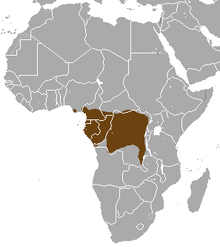Long-nosed mongoose
| Long-nosed mongoose | ||||||||||||
|---|---|---|---|---|---|---|---|---|---|---|---|---|
| Systematics | ||||||||||||
|
||||||||||||
| Scientific name of the genus | ||||||||||||
| Xenogals | ||||||||||||
| Allen , 1919 | ||||||||||||
| Scientific name of the species | ||||||||||||
| Xenogale naso | ||||||||||||
| ( de Winton , 1901) |
The long-nosed mongoose ( Xenogale naso ) is a species of predator from the mongoose family (Herpestidae). Its distribution is restricted to the Central African rainforest block. It used to be included in the genus Herpestes , but this is now rejected due to genetic analyzes.
features
The long-nosed mongoose is a large, dark-colored mongoose with a long snout. It reaches a head-body length of 40 to 61 cm, a tail length of 32 to 42.5 cm and a body weight of 1.9 to 4.5 kg. The outer hair on the top is black-brown and speckled yellow or orange, and relatively long and rough. The undercoat is gray-brown to orange-brown. The fur on the belly side is overall lighter and thinner. The fur on the head is greyish. The quite long-haired tail and legs are black or brownish-black. The feet have long claws and suggested webbed feet.
| 3 | · | 1 | · | 4th | · | 2 | = 40 |
distribution
The distribution area of the long-nosed mongoose covers the entire rainforest block of Central Africa. Here you can find them in southeast Nigeria , Cameroon , the Central African Republic , Equatorial Guinea , Gabon , the Republic of the Congo and the Democratic Republic of the Congo .
habitat
The long-nosed mongoose prefers forests near swamps, forests and river beds near rivers, but also occurs in slightly higher forest areas. It has been proven up to a height of 640 m. A study in the Dzanga Sangha area found that the long-nosed mongoose, previously classified as a rare species, is the most common predator in this area. The long-nosed mongoose mainly lives in higher-lying forests, while the occurrence of the similar marsh mongoose is limited to lower-lying marsh forests. In river forests, the habitats of both species overlap.
Way of life
The diet of the long-nosed mongoose consists mainly of arthropods and small mammals. It also eats fruits, amphibians, snakes, birds, lizards and fish. Components of larger animals such as ducks are rarely found in the droppings of the long-nosed mongoose. The species is predominantly diurnal. At night the animals usually rest in changing hiding places. Long-nosed mongooses usually move on the ground and usually live as solitary animals. Couples are rarely observed. Little is known about reproductive behavior. A litter of three cubs is proven. At around seven years of age, the young reach the size of the adult animals.
Systematics
The long-nosed mongoose was originally included in the genus Herpestes . However, genetic studies have shown a relatively close relationship to the mongoose , which belongs to its own genus Atilax . It is now treated as the only species in the genus Xenogale . Three subspecies of the long-nosed mongoose were originally described. However, these cannot be distinguished morphologically and are therefore not accepted.
Threat and protection
The International Union for Conservation of Nature and Natural Resources (IUCN) classifies the Indian short-tailed mongoose as "not endangered" ( least concern ). The species is partly hunted by humans for its meat. It seems to be rare in the Niger Delta.
Individual evidence
- ↑ a b c d e f J. S. Gilchist, AP Jennings, G. Veron, & P. Cavallini (2009). Family Herpestidaae (Mongooses). In: Don E. Wilson, Russell A. Mittermeier (eds.): Handbook of the Mammals of the World. Volume 1: Carnivores. Lynx Edicions, 2009, ISBN 978-84-96553-49-1 , (p. 311).
- ↑ Justina Ray: Comparative ecology of two African forest mongooses, Herpestes naso and Atilax paludinosus. African Journal of Ecology. Volume 35, Issue 3, pages 237-253, SEPTEMBER 1997.
- ↑ Marie-Lilith Patou, Patricia A. Mclenachan, Craig G. Morley, Arnaud Couloux, Andrew P. Jennings, Géraldine Veron: Molecular phylogeny of the Herpestidae (Mammalia, Carnivora) with a special emphasis on the Asian Herpestes. Volume 53, Issue 1, October 2009, Pages 69–80. online link .
- ↑ Colyn, M., Rompaey, H .: Morphometric evidence of the monotypic status of the African long-nosed mangoose Xenogale naso (Carnivora, Herpestidae). Belgian Journal of Zoology, 1994
- ↑ Herpestes naso in the endangered Red List species the IUCN 2011. Posted by: Van Rompaey, H. Ray, J. & Hoffmann, M. 2008., 2011. Accessed April 24, 2012th
literature
- JS Gilchist, AP Jennings, G. Veron, & P. Cavallini (2009). Family Herpestidaae (Mongooses). In: Don E. Wilson, Russell A. Mittermeier (eds.): Handbook of the Mammals of the World. Volume 1: Carnivores. Lynx Edicions, 2009, ISBN 978-84-96553-49-1 , (p. 311).
Web links
- Herpestes naso in the endangered Red List species the IUCN 2011. Posted by: Van Rompaey, H. Ray, J. & Hoffmann, M. 2008., 2011. Accessed April 24, 2012th

